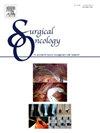用于预测肢端细肌瘤存活率的机器学习模型的开发和外部验证。
IF 2.4
4区 医学
Q3 ONCOLOGY
引用次数: 0
摘要
目的:机器学习(ML)模型已被用于预测多种肉瘤亚型的癌症生存率。然而,还没有人对四肢肌层肉瘤(LMS)进行过研究。ML 是一种强大的工具,有可能更好地预测肢端 LMS:方法:在监测、流行病学和最终结果(SEER)数据库中查询了组织学上的肢端 LMS 病例(n = 634)。记录了患者、肿瘤和治疗特征,并建立了预测1年、3年和5年生存率的ML模型。利用一个四肢LMS患者机构队列(n = 46)对表现最佳的ML模型进行了外部验证:结果:所有 ML 模型在 1 年时表现最佳,在 5 年时表现最差。在 SEER 队列的内部验证中,最佳模型在 5 年时间点的 c 统计量为 0.75-0.76。随机森林(RF)模型是表现最好的模型,用于外部验证。该模型在 1 年期和 5 年期外部验证中的表现也最好,c 统计量分别为 0.90 和 0.87。射频模型在外部验证中校准良好。该模型已在 https://rachar.shinyapps.io/lms_app/ 网站上公布:ML模型在预测四肢LMS的生存率方面表现出色。未来的研究可能需要纳入更多的机构队列,以进一步验证用于 LMS 预后预测的 ML 模型。本文章由计算机程序翻译,如有差异,请以英文原文为准。
Development and external validation of a machine learning model for prediction of survival in extremity leiomyosarcoma
Purpose
Machine learning (ML) models have been used to predict cancer survival in several sarcoma subtypes. However, none have investigated extremity leiomyosarcoma (LMS). ML is a powerful tool that has the potential to better prognosticate extremity LMS.
Methods
The Surveillance, Epidemiology, and End Results (SEER) database was queried for cases of histologic extremity LMS (n = 634). Patient, tumor, and treatment characteristics were recorded, and ML models were developed to predict 1-, 3-, and 5-year survival. The best performing ML model was externally validated using an institutional cohort of extremity LMS patients (n = 46).
Results
All ML models performed best at the 1-year time point and worst at the 5-year time point. On internal validation within the SEER cohort, the best models had c-statistics of 0.75–0.76 at the 5-year time point. The Random Forest (RF) model was the best performing model and used for external validation. This model also performed best at 1-year and worst at 5-year on external validation with c-statistics of 0.90 and 0.87, respectively. The RF model was well calibrated on external validation. This model has been made publicly available at https://rachar.shinyapps.io/lms_app/
Conclusions
ML models had excellent performance for survival prediction of extremity LMS. Future studies incorporating a larger institutional cohort may be needed to further validate the ML model for LMS prognostication.
求助全文
通过发布文献求助,成功后即可免费获取论文全文。
去求助
来源期刊

Surgical Oncology-Oxford
医学-外科
CiteScore
4.50
自引率
0.00%
发文量
169
审稿时长
38 days
期刊介绍:
Surgical Oncology is a peer reviewed journal publishing review articles that contribute to the advancement of knowledge in surgical oncology and related fields of interest. Articles represent a spectrum of current technology in oncology research as well as those concerning clinical trials, surgical technique, methods of investigation and patient evaluation. Surgical Oncology publishes comprehensive Reviews that examine individual topics in considerable detail, in addition to editorials and commentaries which focus on selected papers. The journal also publishes special issues which explore topics of interest to surgical oncologists in great detail - outlining recent advancements and providing readers with the most up to date information.
 求助内容:
求助内容: 应助结果提醒方式:
应助结果提醒方式:


